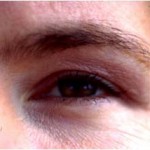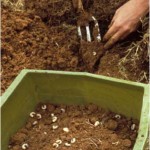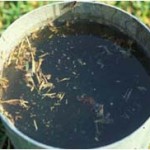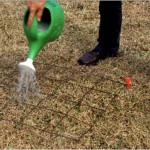The power of observation is the most important trait needed to practice good IPM and is the basis for the concept of Scouting and Monitoring in IPM. (See IPM Concepts)
Visually detecting often small insects and other arthropod pests (e.g., spider mites) may require a magnifying lens (10x), and being at the right place at the right time because some of these critters are only active at night or in some seasons. Scouting, using sampling methods for various insect or arthropods, is a more formalized method of detection that also helps quantify abundance of the organism or the plant injury/damage they cause. The act of scouting periodically over time allows for monitoring changes in pest population density as the season progresses and can help document the impact of any suppression tactics implemented. Sampling methods differ somewhat for turfgrass and ornamental plants.
Turfgrass
Sampling for white grubs and other turfgrass root-feeding beetle larvae like the hunting billbug is accomplished by digging about 6 inches deep into an area of soil such as 1 sq ft (12 by 12 inches) and counting the number of grubs in several locations across the turfgrass area to be able to calculate an average or mean. The “action threshold” for white grubs is 3 to 4 grubs per square foot.
The flotation method is a technique for sampling chinch bugs in turfgrass, and is normally accomplished by cutting both lids from a coffee can or similar container and forcing one end into the turfgrass deep enough to fill the container with water. Chinch bugs float to the surface within minutes where they can be counted to determine the number per unit area.
Soapy water drench (1 to 2 fl. oz. liquid dish washing detergent in 1 gal. water) sprinkled over a 2 by 2 ft. area irritates caterpillars, such as sod webworms, armyworms and cutworms, so they crawl to the top of grass blades where they can be identified and counted to calculate the number of caterpillars per unit area or sample. Monitoring over time will allow documentation of initial apprearance and population level changes over time or in response to treatment.
Ornamental Plants
The underside of leaves can be used as a sampling unit for small pests like aphids, whiteflies, and spider mites by randomly selecting a standard number (e.g., 25, 50 or 100) to examine. Insect numbers can be counted, estimated or merely presence or absence documented will allow for calculation of the average or mean number per leaf or percent infested leaves. Used over time, this method provides initial occurrence and relative population level information and is useful for assessing any treatment(s) applied.
Yellow sticky traps (sometimes other colors) can be made at home using a colored card or other container (e.g., plastic cup) and coating it with a sticky material like Tanglefoot. Winged adult stages of aphids, thrips, whiteflies, leafminers and fungus gnats are attracted and fly to the trap and get stuck. By placing a a number of traps in an area for a set amount of time (e.g., 2-7 days), they can be identified and the number of insects counted (or estimated) to calculate an averaged number of of each type adults per day. By repeating over time, results can document initial arrival and population change over time, including the impact of any treatment(s) applied for their control.
Related
- Bughunter – a website devoted to entomological methods for finding and preserving insects






